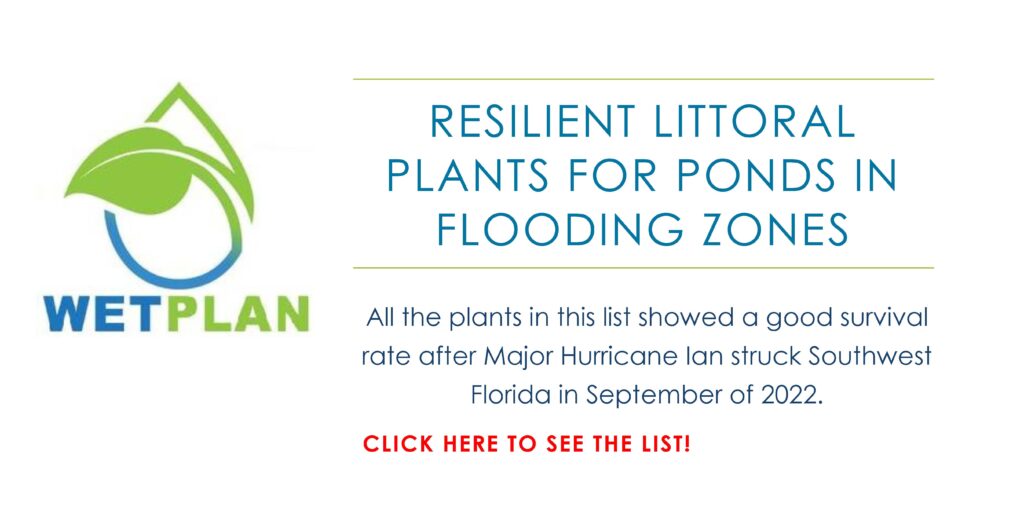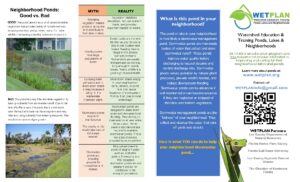Responsible Use and Protection of Your Pond is Important
Good stewardship means learning how to keep your neighborhood stormwater pond healthy, functional, and attractive.

What you call a lake may not be a lake
- What you call a “lake” may be a man-made stormwater management pond designed to treat storm water pollution.
- Stormwater management ponds are often mistaken for lakes. But, these ponds play a distinctive and important role in managing surface water quality and quantity.
- Stormwater ponds are man-made, engineered devices.
- Stormwater ponds are part of the neighborhood’s stormwater management system that was designed, permitted and built during the planning and construction stages of your development to capture runoff.
- The pond or lake in your neighborhood is most likely a stormwater management pond. Stormwater ponds are man-made bodies of water that collect and store stormwater runoff. These ponds improve water quality before discharging to natural streams and control water quantity. Stormwater ponds reduce pollution by physical settling and natural plant processes, along with providing wildlife habitat and reducing downstream flooding. Stormwater ponds can be attractive if well maintained or can become eyesores if they are neglected or stripped of shoreline and bottom vegetation.
- Stormwater management ponds are the “kidneys” of your neighborhood. They collect and cleanup the water that runs off yards and streets.
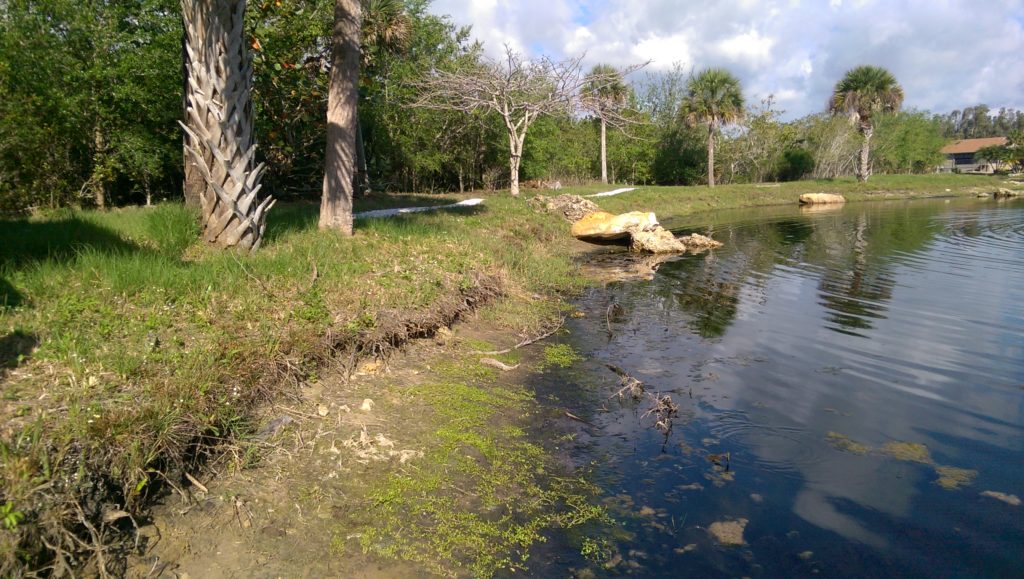
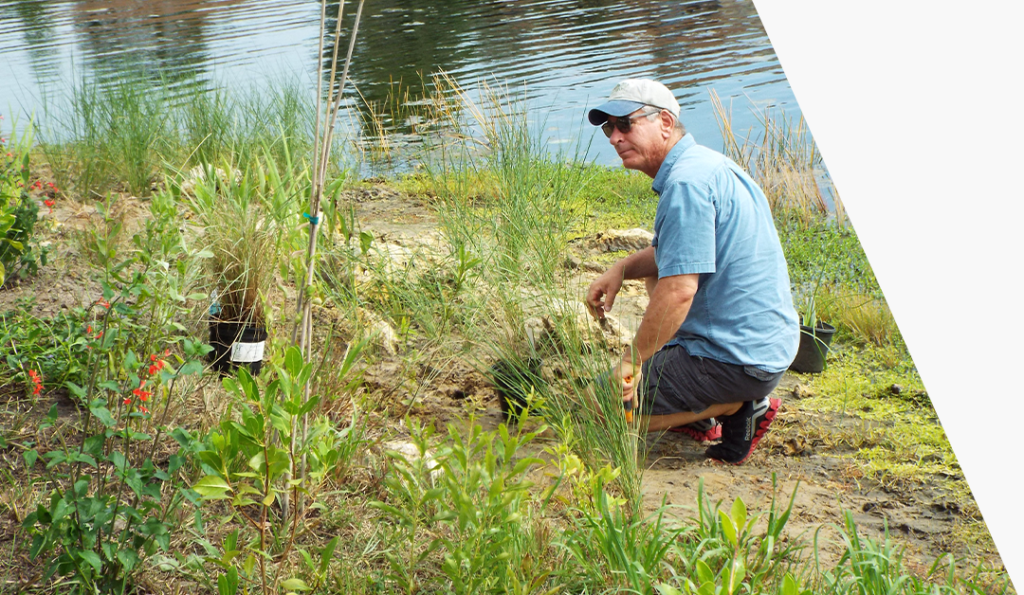
- Your stormwater pond provides many benefits to your community. When they are well managed, they are beautiful and increase your property value. On top of this, they can improve water quality by treating pollution, decrease flooding and provide essential wildlife habitat.
- Management of stormwater runoff from roads and parking lots, and reduction of flooding.
- Protection of water quality and the health of our waterways by filtering pollutants from water before discharge to creeks, rivers, wetlands, or the Gulf.
- While the stormwater pond is designed to reduce pollutants leaving the area, removing pollutants, such as grass clippings, from the road will increase the life of the pond and decrease the maintenance costs.
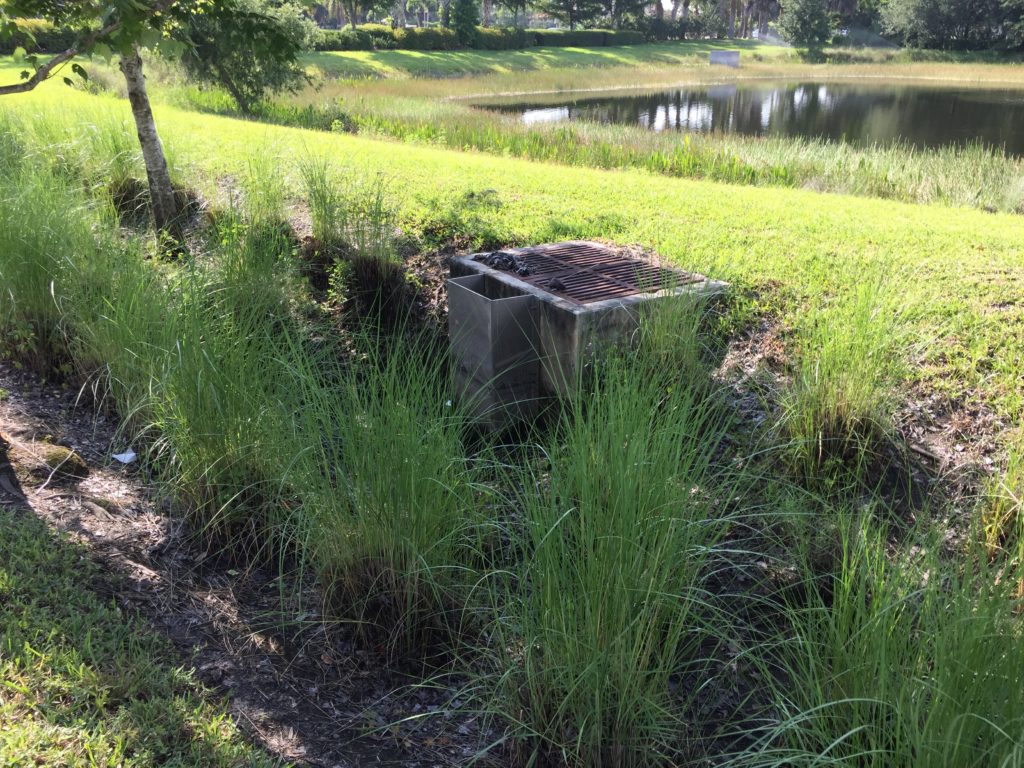
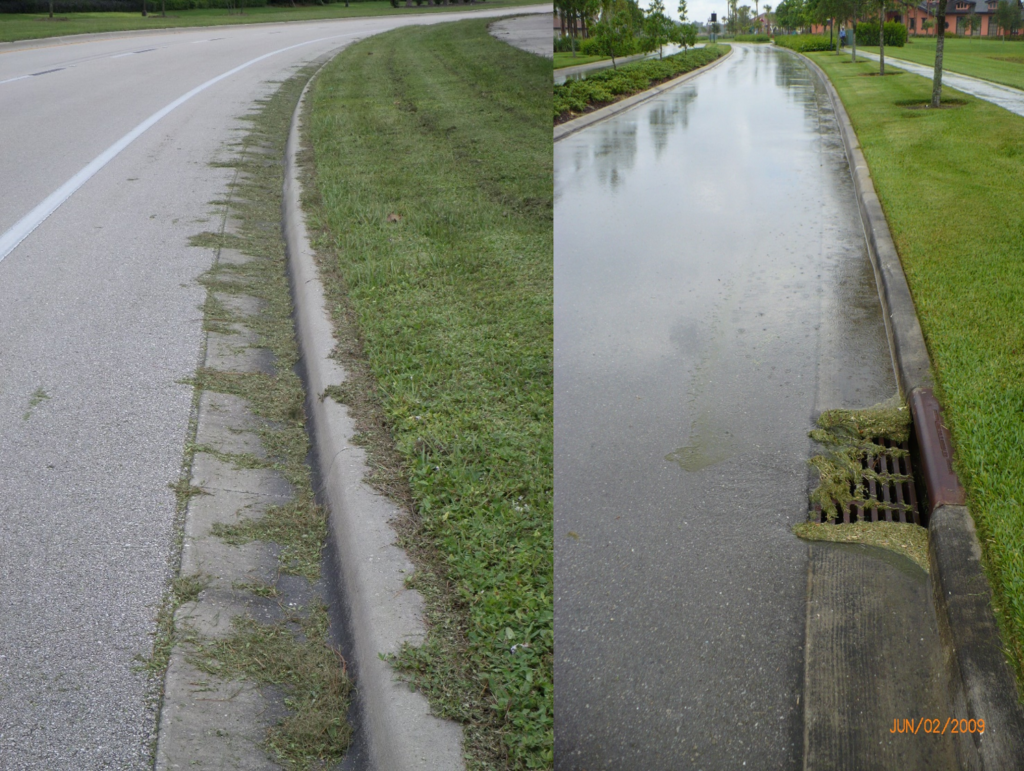
- Untreated stormwater runoff carries sediments, bacteria, oils, fertilizers, pesticides, and herbicides, which are some of the more common contaminants.
- Storm drains in your neighborhood empty into the stormwater pond.
- Stormwater runoff can carry nutrients that could overload aquatic systems producing eutrophication. This could cause algae blooms and fish kills.
- Grass clipping, as shown in the picture, are a source of storm water pollution.
- A well-managed pond can be:
- An aesthetic amenity
- A habitat for fish and wildlife by providing food, shelter, breeding grounds.
- A pond holds water and provides it to recharge aquifers for groundwater supply, decrease irrigation needs and improve the saline balance in the estuaries.
- Proper long-term management prevents costly restoration in the future.
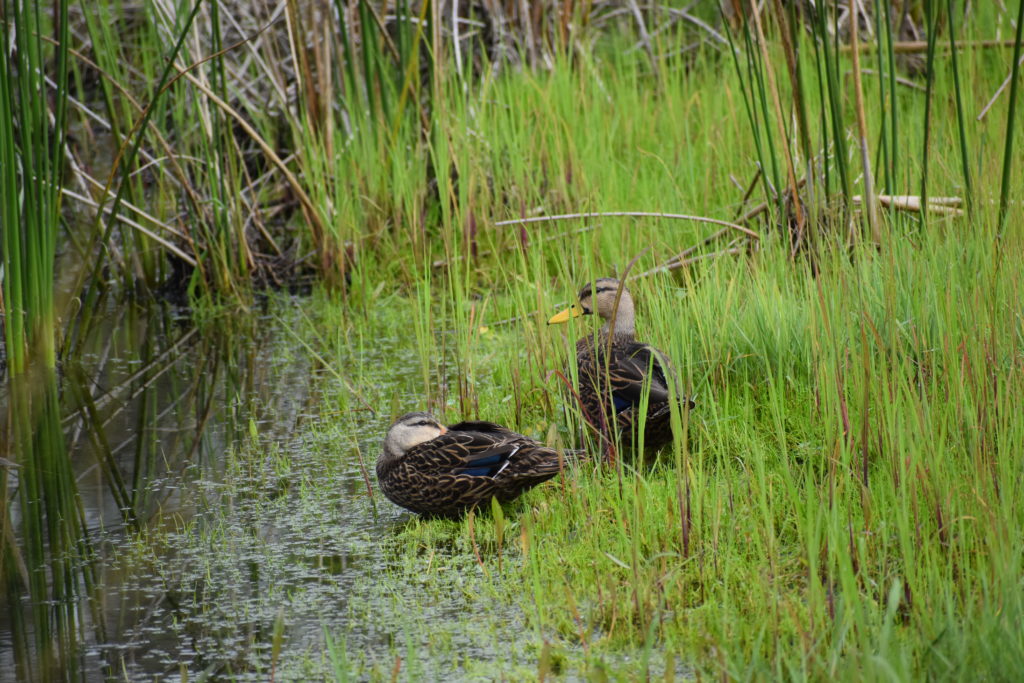
DID YOU KNOW?
- One of the main purposes of stormwater ponds is to remove pollutants before they reach the natural waterways.
- The plants and algae that some homeowners find intolerable are what provide this pollution removal function.
- Near the shore area is where sunlight penetrates all the way to the sediment and allows aquatic plants and beneficial organisms to grow.
Good Housekeeping
These good housekeeping activities will result in the following “Healthy Pond” characteristics.
Activities
- Don’t mow the grass to the edge of the pond.
- Adhere to fertilizer ordinance – keep nutrients on the lawn and out of the pond!
- Maintain pond buffer zone.
- Avoid destroying natural vegetation in and near the water’s edge
- Control non-native invasive vegetation.
- Don’t dump waste into storm drains.
- Keep storm drains free of debris and sediment.
Results
- Low maintenance buffer zone and improved water quality
- Healthy pond free of algae blooms, improved diversity of fish and wildlife present.
- No bare soil or washouts along shoreline
- Vigorous littoral zone vegetation coverage
- Minimal invasive or nuisance species
- Absence of pet waste, yard debris, and trash
- Reduced contaminants in your pond
- A stormwater pond that functions and looks like a lake.
Things to Know
Do NOT feed! Establish buffer zone with no turf. You can learn more at https://myfwc.com/wildlifehabitats/wildlife/waterfowl/nuisance
Causes/Description
- Mowing vegetation at the edge of the water creates desirable habitat for Muscovy ducks.
- Feeding Muscovy ducks.
Corrective Actions
Contact Florida Fish & Wildlife Conservation Commission for assistance with removal and population control. https://myfwc.com/conservation/you-conserve/wildlife/remove/ or 850-488-5878
Preventative Steps
- Don’t mow grass to the edge of the pond. Allow native vegetation (shrubs and grasses only) to grow 6 ft. from the edge of the pond. This allows for a natural buffer.
- Don’t feed Muscovy ducks.
Aeration! Add submerged and emergent plants. NO grass clippings, pet poop, or feeding wildlife.
Causes/Description
Fertilizers, grass clippings, and pet waste contain nitrogen and phosphorous that increase algae growth. Sunlight stimulates algae growth.
Corrective Actions
Reduce the amount of nutrients entering the pond (i.e. fertilizers, pesticides, grass clippings, pet waste, etc.). Install aerators. Balance fish populations. Analyze the water in the pond to identify the algae bloom.
Preventative Steps
Reduce or eliminate the use of fertilizer products on lawn. Prevent grass cuttings and pet waste from entering water. Reduce nuisance waterfowl population.
Stabilize bank with shoreline plants.
Causes/Description
Water flowing over bare soil transports soil directly into ponds and causes erosion and water pollution.
Corrective Actions
Plant vegetation and mulch to cover bare soil and help reduce soil erosion. When vegetative measures are not adequate, place rip-rap or other appropriate shoreline stabilization near the waterline with municipal approval.
Preventative Steps
Avoid destroying natural vegetation (shrubs & grasses) near the water’s edge. Plant and mulch any exposed soils. Reduce areas with steep slopes around stormwater ponds.
Remove invasive critters, don’t dump water into pond, don’t release aquarium animals.
Causes/Description
Plants and animals that are not native to our ecosystem, such as hydrilla and tilapia, can cause environmental and economic harm by destroying plant and animal habitats, damaging native fisheries and clogging water intake and discharge pipes.
Corrective Actions
Physically remove non-native species before they become well established. Plant native species. Consult local Community Development Department for assistance.
Preventative Steps
Never dump discarded household waters, plants, fish or animals in to a body of water unless they came out of that body of water. Contact Extension Services for assistance with planting projects.
Causes/Description
Snakes and alligators are part of the natural fauna. Your neighborhood was built in their habitat and they do not know where else to go!
Corrective Actions
Contact Florida Fish & Wildlife Conservation Commission for assistance with removal and population control or nuisance wildlife. https://myfwc.com/conservation/you-conserve/wildlife/remove/ or 866-FWC-GATOR.
Preventative Steps
Assume snakes and alligators live in all water bodies in Florida and be cautious. Do not kill or harass them, as many are protected by law.
Causes/Description
Most storm drains discharge directly into ponds or nearby streams and carry chemicals, soap, litter etc. from the land directly to the water without being treated.
Corrective Actions
Marking or stenciling storm drains reminds people not to put anything into storm drains. Contact the Household Hazardous Waste Facility to dispose of toxic chemicals: 239-477-1000.
Preventative Steps
Don’t dump anything into storm drains. Wash vehicles on lawn not driveway or take to car wash to prevent soap from entering waterways. Properly dispose of chemicals and litter.
You may think pet poop is harmless… but it is not! Every day, more than 13 TONS of dog waste doesn’t get properly disposed of in Lee County. That’s just scary!
- Regularly collect your pet’s waste in your yard
- Do not let it sit for more than a couple days. Your lawn will thank you too, as pet waste often will kill the grass where it was located.
- Monitor your dog’s waste in public places. Do not simply allow your pet to go “do its business” in public without picking it up.
Consult with County or City
Good Pond
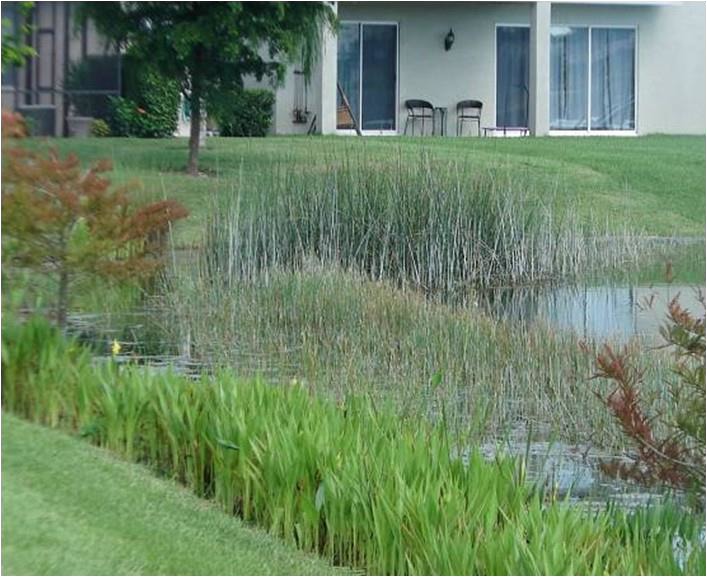
Bad Pond
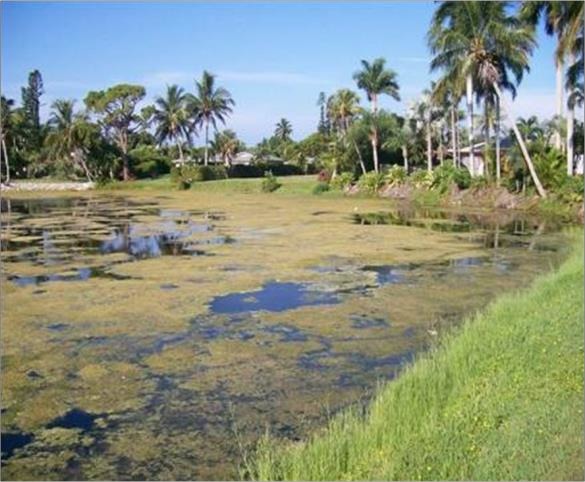
Myth
Reality
Shoreline vegetation makes ponds unattractive and contribute to their deterioration.
Vegetation stabilizes shorelines, reduces nutrient loads and provides important habitat for wildlife.
Healthy ponds host large populations of ducks.
Exotic ducks are the wildlife that usually choose to stay in one location and breed, creating nutrient problems. Native birds are usually transient and do not stay long enough to create issues. Native wildlife is a good sign of pond health.
Dumping trash, pet waste and oil down storm drains is okay because it will go to the water treatment plant.
Most storm drains empty to your neighborhood canal, stream or pond. There is no sewer treatment of stormwater in Florida. It all goes to local waterways!
Stormwater ponds require no maintenance.
The county or city would take care of it if it were needed.
Stormwater ponds are designed to clean stormwater and decrease local flooding. They do require maintenance at least a few times a year. Homeowners associations are required to maintain stormwater ponds. This is not a taxed service provided by municipalities.
Stormwater ponds are breeding grounds for mosquitoes and snakes.
Mosquitoes breed in pools of stagnant water such as birdbaths, gutters, flowerpots, etc. Well-designed stormwater ponds are not stagnant and do not contribute to the mosquito population.
Control Algae Blooms
Follow these guidelines to help prevent and control algae blooms in your pond.
- Keep fertilizers off of roads and driveways after spreading to prevent it from washing into storm drains.
- Decrease or eliminate the use of fertilizers on the bank slopes of ponds.
- Properly dispose of grass clipping and yard waste.
- Pick up pet waste and throw in the trash.
- Wash cars on the lawn not in the driveway.
- Allow fish, turtles, and waterfowl to find their own food. Plant shoreline wetland plants to filter runoff and absorb nutrients.
- Install floating wetlands to utilize nutrients from the water.
- Install aeration – bubblers.
- Avoid copper sulfate in your stormwater pond.
Mimic Nature
Healthy ponds can have lawns if you follow these guidelines.
- Follow fertilizer ordinance “black out periods.”
- Establish buffer of plants between turf and pond – 6 feet minimum, 10 feet is better.
- Keep grass clippings out of pond, storm drains or swales.
- Do not feed wildlife.
- Limit chemical treatments.
- Use aeration (bubblers).
- Periodically harvest submerged vegetation.
More
Assistance
- Pond Watch: Lee County Hyacinth Control District
- Lee County Division of Natural Resources
- Local Governments
- Environmental Consultants
- Florida Native Plant Society ( Coccoloba Chapter)
- UF-IFAS Extension Services
- Befloridian.org
Actions You Can Take
- Minimize pollutants to control aquatic weeds & algae
- Avoid over irrigating your yard.
- Compost or properly dispose of yard waste.
- Plant natives or Florida Friendly vegetation in your yard to reduce the need for fertilizers & irrigation.
- Plant rain gardens & use rain barrels to minimize stormwater runoff from your yard.

